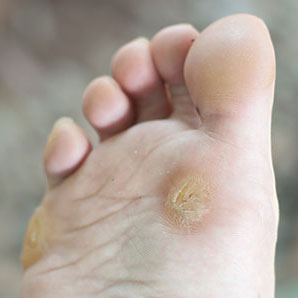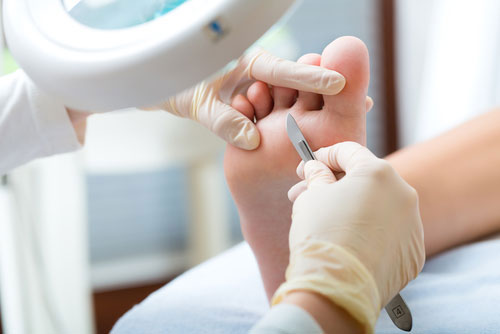Corns and Calluses
Corns and calluses are thick, hardened layers of skin that develop when your skin tries to protect itself against friction and pressure.
Corns are small, conical-shaped areas of hard skin that press on underlying nerve endings, often causing considerable pain. They usually occur on the toes or soles of the feet (plantar corns), almost always over a bony prominence, such as a joint.
A corn is simply an excess of skin cells in one spot due to pressure or friction on that part of the foot, whereas a callus develops over a larger area of the foot.
Traditionally, poor footwear has been held responsible for causing corns, but we now know it is not as simple as this. If the foot is unstable, excessive pressure will fall on the toes and soles of the feet, and the skin thickens on these areas for protection.
Types of Corns
There are five different types of corns with the two most common being hard and soft corns.
Hard Corns

Hard corns that develop on the toes or soles of the feet are often a sign of improper foot function. Simply removing a corn without addressing the underlying biomechanical foot issue is likely to provide only temporary relief.
Soft Corns

These develop similarly to hard corns, but are almost always found between the toes and have a soft, white appearance due to the moist condition of the skin.
A fungal infection of the skin is often present, and the skin is moist from sweat or inadequate drying.
Seed Corns
These tiny corns typically appear singularly or in clusters on the sole of the foot. Seed corns are usually painless.
Vascular or Neurovascular Corns
These corns have nerve and/or blood vessel involvement, and they may bleed profusely if cut, causing significant pain.
Fibrous Corns
These develop from corns that have been present for a long time. They typically have a white appearance and are more firmly attached to deeper tissues than other types of corns. Fibrous corns may also be painful when pressure is applied.
Treatment of Corns and Calluses
There are numerous self-treatments commercially available, from corn knives to corn plasters containing caustics that destroy the thickened skin.
However, these self-treatments should be avoided as they can be potentially very dangerous. Do not cut a corn yourself, especially if you are elderly or diabetic. Also, do not use corn plasters or paints as they can burn the healthy tissue around the corn.
Instead, you could use a pumice stone to remove the thickened skin a little at a time, or relieve pressure between the toes with a foam wedge.
If you are unsure of what to do, or need special attention, please consult a registered Podiatrist/Chiropodist at The Abbots Langley Foot Clinic.
Corns can easily be removed to provide instant relief; however, if the underlying cause is not addressed, the corn may return.
Call 01923 268787 to book an appointment
Clinic Information

Opening Hours
| Monday – Thursday: | 8:30 am – 6:00 pm |
| Friday: | 8:30 am – 5:30 pm |
| Saturday: | 8:30 am – 2:00 pm |



